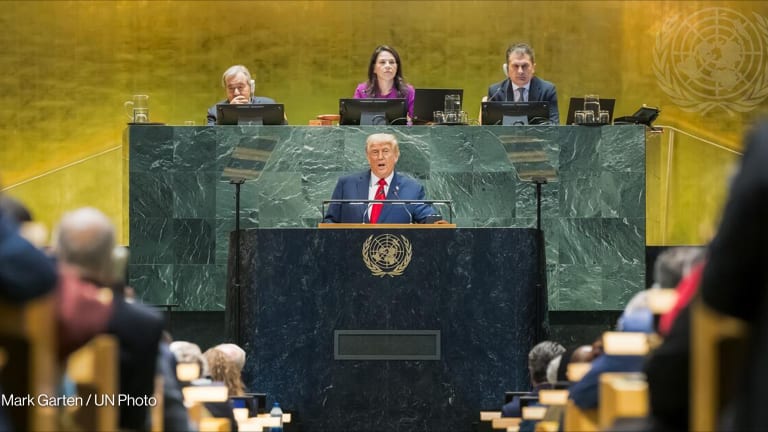How has migration shaped development policy?
Development and migration are closely connected in several ways, and at this moment, there seems to be a rising sentiment against both. To what extent is this connected?
In recent years, migration has become one of the most prominent issues in Western politics — including across almost all of the world’s leading aid donors. The United States, the United Kingdom, and Germany have all seen anti-immigration protests — sometimes riots — and a swing to anti-immigration political parties. With the trend showing no sign of abating, we wanted to know: How have concerns about migration shaped aid? And what does it mean for the future of aid? Have concerns about migration affected aid funding? Many of the world’s biggest donors — including the U.S., the U.K., Germany, France and the Netherlands — have cut aid over the past year or two, sometimes dramatically. All of these countries are also experiencing strong anti-immigration sentiment, and a pushback against supporting asylum-seekers and refugees. But are the two things connected? Not directly, according to two experts who spoke to Devex. “My sense is that the aid cuts have been driven more by economic factors — post-financial crisis economic stagnation and post-Covid debt and inflation, combined with a general (incorrect, in my opinion) sense that aid is often wasted and inefficient,” said Lee Crawfurd, a senior research fellow at the Center for Global Development. In fact, despite huge political changes around aid in the past few years, public opinion on the issue across many of the big donors appears to have remained broadly stable since the 2010s, supporting the theory that cuts are largely being driven by economic factors rather than public opinion. Claire Kumar, a senior research fellow at the think tank ODI Global who has undertaken extensive research on the links between aid and migration in Europe, agrees. “I would say the cuts are largely driven by both economic and geopolitical factors,” she said. Geopolitical factors include the need to spend more on defense — at least for European donors, given Russian aggression and unpredictable support from the U.S. Aid cuts in the U.K. earlier this year were explicitly tied to the need to increase defense spending. Additionally, amid increasing competition and fragmentation globally, “We have seen a rising focus on national self-interest,” Kumar said. Yet there is one direct way in which migration has reduced overseas spending, and that’s through refugee support costs. The Organisation for Economic Co-operation and Development’s Development Assistance Committee — the body responsible for setting the rules on aid spending for most of the world’s biggest donors — allows aid to be spent on supporting asylum-seekers arriving in donor countries for the first year of their stay. With a rise in asylum-seekers in Europe following Russia’s 2022 invasion of Ukraine — and perhaps to assuage public frustration about the costs of supporting refugees — some governments have dipped heavily into the aid budget for funding. As a result, in 2023, nearly 15% of aid was spent within donor countries. A politically charged issue While concerns about immigration might not be directly responsible for aid cuts, these issues have become tied up together, explained Kumar. In the past, aid was “a really low salience issue” in the public realm, she said — there wasn’t a lot of controversy or discussion over it and it wasn’t high up the political agenda. “That has changed very significantly,” because as concerns about migration grew, politicians started suggesting that aid could be used to stem migration. As a result, at least in the European context, “unfortunately now aid policy is inextricably linked to a very controversial policy arena.” More broadly, both of these issues — the turn away from immigration and aid — can also be seen as a manifestation of the “my country first” mentality that is being embraced by populist right parties and their supporters across Europe, the United States, and elsewhere. In Japan — the only top five donor where immigration is not yet a major political concern — the aid budget has mostly continued to climb, although it did dip last year. But even there — a country with some of the lowest levels of immigration among high-income countries — the government is starting to feel similar pressures. Naoki Ando, senior vice president of the Japan International Cooperation Agency, recently told the Financial Times that there were “strong headwinds” against the agency’s work amid a rise in “Japan first” thinking. And it’s notable that in the nation that’s perhaps most explicitly pursuing a “my country first” agenda — the United States — the aid cuts have been the starkest. Anti-immigration sentiment has fueled the “Make America Great Again” movement, and empowered a leadership which is far more hostile to the idea of funding aid. Have concerns about migration affected aid policy? Beyond aid cuts, a much clearer line can be drawn between concerns about migration and changes to aid policy, which in many cases has become more transactional. Donor governments have sought opportunities to be seen to be tackling migration, including through aid. It’s a trend which has been seen clearly for at least the past decade — since the 2015 European migration “crisis,” when more than a million asylum seekers arrived in Europe, driven largely by the conflict in Syria. The U.K. aid strategy launched in 2015 pledged to tackle “the root causes of mass migration.” Around the same time, the EU launched an Emergency Trust Fund for Africa dedicated to “addressing root causes of irregular migration,” with €5 billion pledged so far. The U.S. soon adopted similar language. This shift has introduced a “transactional” element into aid policy, said Kumar, under which funds are diverted to projects that are intended to tackle migration. Some of those projects clearly fall within the parameters of poverty reduction — such as providing services or job creation programs — but there are concerns that aid is also being used for border security initiatives. The EU has also moved to make aid conditional on recipient country governments cooperating on migration. The European Council on Refugees and Exiles, an alliance of refugee rights organizations,has argued that this policy could make EU aid “less effective,” and in some cases risks legitimizing repressive or corrupt governments that are partially responsible for fueling migration in the first place. Have concerns about migration affected aid communications? The move to migration-focused aid has happened within a broader shift toward framing aid as being in “the national interest” — something that benefits the donor country as much as the recipient. There are various ways in which this narrative is presented, some of which are more aligned with the overall goal of poverty reduction than others. Proposed benefits might include contributing to global stability, enhancing soft power influence, generating economic advantages, or tackling the drivers of migration. In an explainer for ODI’s Principled Aid Index, researcher Rachael Calleja wrote that “A principled national interest [approach] advances a donor’s interest by engaging with development challenges to create a safer and more prosperous world. An unprincipled approach puts development outcomes second to the short-term political or commercial interests of donors.” Some political leaders and aid advocates see appealing to the national interest — rather than to altruism — as a more effective way to sell aid to an increasingly skeptical public or to political players who might otherwise be disinclined to support it. Such arguments were prominent in the early response to President Donald Trump’s assault on U.S. aid earlier this year, with advocates noting that a U.S. withdrawal from aid would leave space for China to fill the gap and increase its global influence. However, Kumar’s research found that while there are particular narratives around aid that can successfully maintain and increase support for it — including narratives that focus on the national interest — migration in particular is the “most divisive” part of that narrative. If the goal is to foster support for aid, “the smart thing is to exclude [migration] from the conversation,” she said. She added that “because aid cannot in practice really address migration … ‘selling’ aid on the basis that it can tackle migration makes aid also look very ineffective. So it does not help the case for aid at all.” Nonetheless, Kumar believes the issue of migration “is going to remain on the agenda for a long time,” continuing to influence how aid is spent — which is “disappointing given that there is no credible evidence that shows that migration-related aid can deliver the objectives the EU and European countries want,” she said.
In recent years, migration has become one of the most prominent issues in Western politics — including across almost all of the world’s leading aid donors. The United States, the United Kingdom, and Germany have all seen anti-immigration protests — sometimes riots — and a swing to anti-immigration political parties.
With the trend showing no sign of abating, we wanted to know: How have concerns about migration shaped aid? And what does it mean for the future of aid?
Many of the world’s biggest donors — including the U.S., the U.K., Germany, France and the Netherlands — have cut aid over the past year or two, sometimes dramatically. All of these countries are also experiencing strong anti-immigration sentiment, and a pushback against supporting asylum-seekers and refugees.
This story is forDevex Promembers
Unlock this story now with a 15-day free trial of Devex Pro.
With a Devex Pro subscription you'll get access to deeper analysis and exclusive insights from our reporters and analysts.
Start my free trialRequest a group subscription Printing articles to share with others is a breach of our terms and conditions and copyright policy. Please use the sharing options on the left side of the article. Devex Pro members may share up to 10 articles per month using the Pro share tool ( ).
Jessica Abrahams is a former editor of Devex Pro. She helped to oversee news, features, data analysis, events, and newsletters for Devex Pro members. Before that, she served as deputy news editor and as an associate editor, with a particular focus on Europe. She has also worked as a writer, researcher, and editor for Prospect magazine, The Telegraph, and Bloomberg News, among other outlets. Based in London, Jessica holds graduate degrees in journalism from City University London and in international relations from Institut Barcelona d’Estudis Internacionals.








